
I am sorry for Broken Janglish. After this issue, I will introduce it on an irregular series.
Unlike Japan, the dishes used in Chiang Mai's mass eateries and the general public's house still contain plenty of synthetic resin. It is probably because of the practical reason that it is hard to break, but because there is no aesthetic concern for dishes and bowls. However, back in time, in the Northern Thailand region, the production of ceramics commonly used by ordinary people was done. Sukhothai, Si Satchanalai, and Lan-Na were all born with attractive pottery of various styles. It was also brought to Japan and prized among 【茶人:Tea masters】and others.
Here, we will explain the basic knowledge of Lan-Na old ceramics which has not attracted attention, and introduce representative kiln sites and their characteristics.

Found Dishes(Plate)at antique shops in Tha-Phae street
From the end of March 1995 to the end of September 1999, I went to M Company operating in Lamphun's northern industrial estate. On a holiday I watched the Sankampaeng ware at an antique shop in Thapae Street. From that time on I became interested in medieval Lan-Na ceramics and kiln sites.
I caught a pottery of Sankampaeng at an antique shop on Thaphae Street on a holiday.
When I was a child, there was a kiln in the village called 【萬祥山:Banshowzan】near the house where I went to play and watched the process of pottery making such as cray kneading, molding, firing etc. Based on such experiences, when I stayed here(Chiangmai) I saw antique shops and saw it mainly Chinese ceramics. In the third year I visited at the antique shop in Thaphae Street, a dish(plate) of wheat color or skin color was in my eyes. The antique shop was mainly dealing with Chinese ceramics and pottery which seems to be a copy. However, I saw Plate which is different from them. When I asked the owner of an antique shop, So it was Sankampaeng.
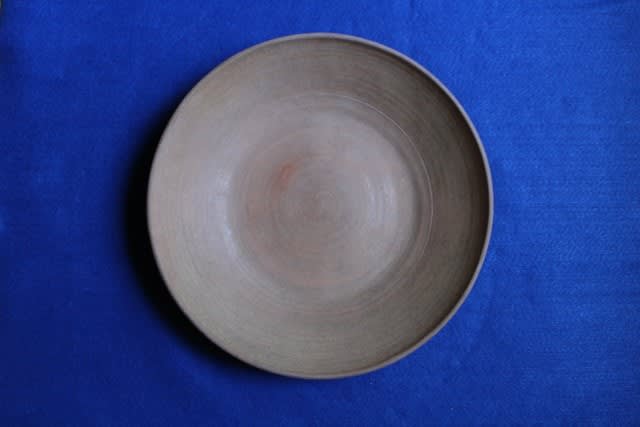
(Dog’s plate: Author's collection)
It was an irresistible dish(plate) without decorations hung ash glaze in the skin color(like ivory color), but when I thought that it was made by an unnamed potter who did not act, I felt lonely and the price was about 1700 Baht I bought it from that. After returning home, I examined variously, it was a decorative less plate called "dog's plate" and I knew that there would have been more than 80 kilns in Sankampaeng-On Thai district around the 14th and 15th centuries.
That is the reason I came to today to look Thai ceramics in Japanese museum, appreciation of old ceramics in museums around Thailand, and even touring Old-kiln sites.
Lan-Na’s Kiln, Ceramics and its features
In the medieval Lan-Na kingdom, ceramics were fired in various places. I show a representative kiln at Google Earth.
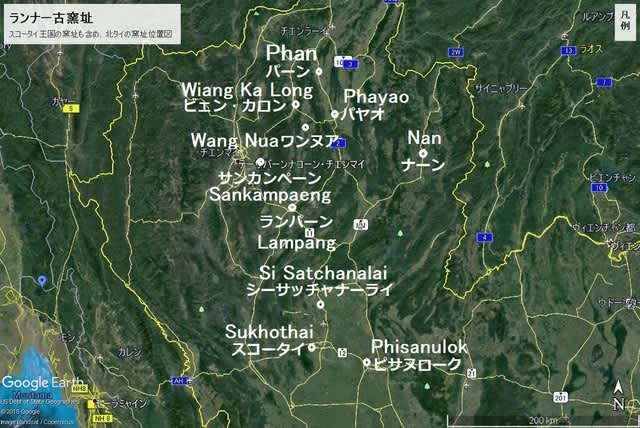
Although it is written as ceramics or old ceramics here, there is a big difference between pottery and porcelain. For rough expression, the material of the pottery is clay, the firing temperature is less than 1200 ℃. Porcelain is obtained by pulverizing minerals such as feldspar to powder, adding tethering clay (kaolin) and water and molding and then firing at 1200 - 1400 ℃. However, there is so-called celadon which is mainly clay, and it is reduced and fired by applying iron glaze to it. Therefore, in this report we will refer to "ceramics" or "old ceramics". Speaking of pottery, the pottery with white inlaid pattern has been fired in reddish brown color in the Kingdom of Haripunchai before the king of Mengrai built the kingdom of the Lan- Na, but pottery which does not use glaze is not touched here I will.
Each kiln in the Lan-Na has its own characteristics, but I will introduce it from the overall features.
1. Most of the Lan-Na’s ceramics are pottery
2. Pottery decorations also have patterns using stamps, but in many cases they use iron paintings
3. Glaze is based on ash glaze
4. A kiln is a hole kiln or what it was built on the ground and its format is the same
First one, The Lan-Na's wear is a pottery like a firing temperature is less than 1200 degrees for most. It is different from the porcelain to be fired at high temperature, like 【伊万里:Imari】 ware made in Japan. So playing the edges of the pottery plate or dish with your fingers makes it dull, different from that of porcelain’s metal sound.
Secondly, the decoration of the Lan-Na pottery is iron painting, there is no 【青花:blue and white】using cobalt pigment. When pigments containing iron are painted with brush, fish and flowers-grass are drawn and fired, the pigment part develops from blackish brown to brown to become a pattern. All the ceramics with patterns at Lan-Na’s like this are iron paintings.
Third, the glaze is based on ash of woody and grass, which forms vitreous covering the surface of fired ware. If a small amount of iron(red cray) component is contained, it becomes celadon if it is fired in the reducing atmosphere, and when fired in oxidizing atmosphere it develops to wheat color or skin color(like ivory color).
For the fourth, it is difficult to describe it in a word, but the Lan-Na 's kiln is a hole kiln. Speaking of a hole kiln, in Japan it is a kiln that burns 【須恵器】SUEKI, which makes a hole in the slopes of mountains and hills to make a kiln. This type of kiln is a Lan-Na kiln. However, in the Lan-Na, the underground type hole kiln exists in Wiang Kalong and Phayao, and the other kiln fields are semi-underground type and ground-based hole kilns of the same shape. Although it will be somewhat professional, We call this hole kiln a cross draft kiln. The kiln was equipped with a heating pot, and the fire-chamber where items are arranged is a type with a chimney in the last part, commonly used in various Lan-Na and used in medieval times.

Typical cross draft kiln of the Wang-Nua kiln has been moved to Chiangmai National Museum
I introduced the overall characteristics of the kilns and firing ceramics in the Lan-Na area, but I would like to add a little more about the hole kiln. I have introduced that this hole kiln is a primitive shape. So, was this primitive hole kiln spontaneously built and used in northern Thailand? According to a Report by Mr. Don Hein, a professor at the University of Adelaide in Australia, the hole kiln that occurred in China in the BC, along with the passage of time, was founded in【安南:Annan (Vietnam)】and the possibility of being brought to Lan-Na via North of Laos. These are the overall characteristics of the kilns and firing ceramics in the Lan-Na area.
Where then was Lan-Na ceramics consumed? Most of them were consumed in the Lan-Na area, and there was supply to the outside world, but it was a very small number. The reason is that the Sukhothai kiln and the Si Satchanalai kiln existed in the Sukhothai kingdom, especially the Si Satchanalai kiln was a powerful rival and almost monopolized Thai exported ceramics. In other words, it was used in the Lan-Na area, but the medieval Lan-Na society was a class society. There is an early ruin of the Lan-Na dynasty at south of Chiang Mai called Wiian Kumkam and Wiang Thakan. In the excavation there, blue and white ceramics(porcelain) of China / Jingdezhen (Japan is called 【染付:Sometsuke】) will be excavated with ruin of the Lan-Na.
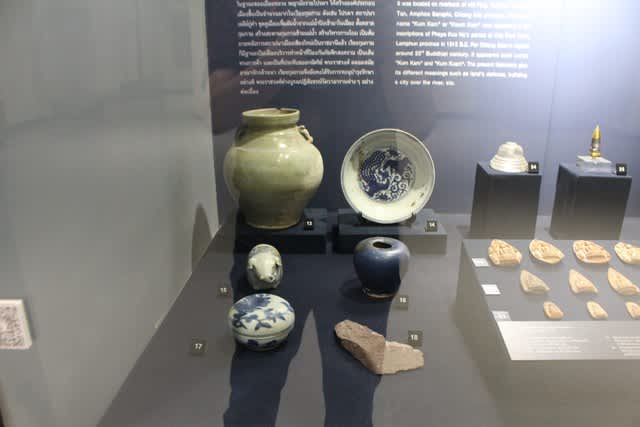
Chinese ceramics excavated from Wiang-Kumkam
This blue and white ceramics is thin and hard. It was a fascination dish that looked beautiful and charming. These porcelains are consumed by high-society such as royal family, aristocrats, or officials, and it is considered that ordinary people used Lan-Na’s ceramics.

Sankampaeng ceramics and old kiln site
Kiln sites were scattered in the On Thai area of SanKampaeg district, and there were over 80 kilns in total. Characteristics of the pattern of Sankampaeng ceramics are twin fish pattern and occupy over 60% of the whole.
There are two kinds of twin fish pattern. Iron painting pattern is one of them. Another one is pressing a fish stamp on the dish surface when the dish is half dried. A case example of the iron picture is introduced at the beginning. Here, I will introduce the case of 【印花双魚文:Stamped twin fish pattern】dish.
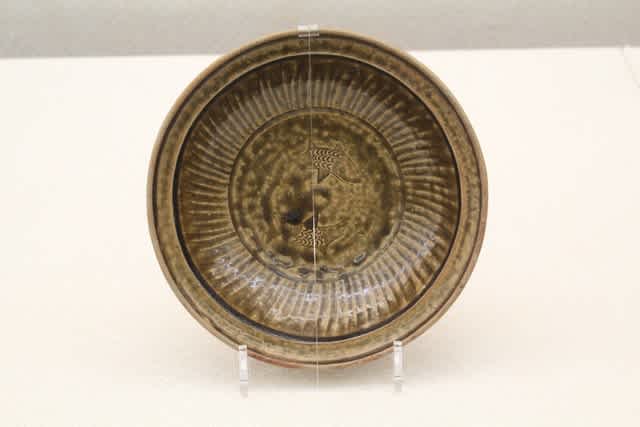
Brown glazed plate, with Stamping twin fish pattern: MACHIDA city Museum
In the ancient country of the china, the eggs of fish are prolific, it turns into a meaning of descendants and families' prosperity, and it is called 【吉祥文:Kishyo-mon】pattern. This seems to have influenced North Thailand. Here, the iron picture twin fish pattern is subjected to celadon glaze and ash glaze, Stamped twin fish pattern has brown glaze feature, and has not vice versa.
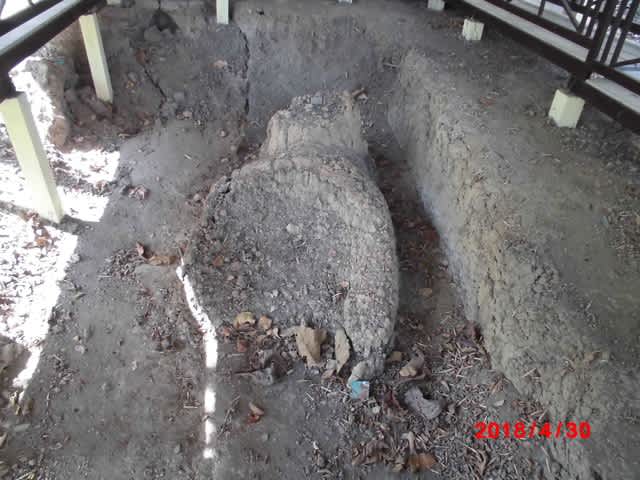
Sankampaeng Wat Chiangsaeng old kiln site
In the old kiln site, Wat Chiangsaen Kiln is relatively original shape. Recently a new hut has been made, and we can see the kiln site from all sides.
The total length of the kiln is less than 3 m and in the Northern Thailand it is the smallest kiln. I feel amazed that fired beautiful celadon of vivid color with such a small kiln. In order to firing celadon, it is necessary to fire in reducing atmosphere by restricting the inflow amount of air into the kiln. Such a way of firing is difficult to keep airtight because the pressure of the kiln increases. Therefore, the ceiling part of the kiln is easy to collapse, and when you visit the kiln site you can see the ceiling collapsed.
Wiang-Kalon ceramics and old kiln site
Ceramics(Potteries), commonly called Wiang-kalon, appeared in the 14th century, and the pottery is scattered over a large area. Many are Wiang-kalon sub-district in Chiangrai province, but they also exist in Wang-Nua district Lampang province, which crossed over a ridge. Therefor, the characteristics of fired pottery varies depending on the kiln group, the form of the kiln is the same, but type has variety as underground type, semi-underground type, ground type.
First of all, although there are five characteristics of ceramics, I would like to introduce only the features of iron painting from within the five form. The pattern popular with Wiang-Kalon is a bird’s pattern shown in the photograph, flower pattern like chrysanthemum and crow seems to spread wings.
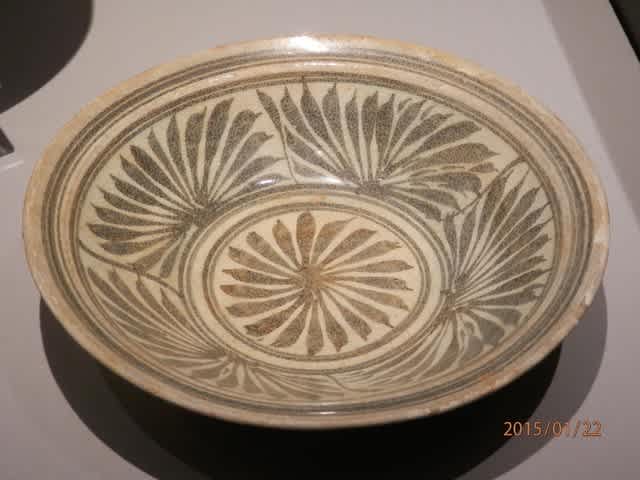
Ka-Long: Iron painting-flowers pattern plate, BKK university-Southeast Asian Ceramics Museum
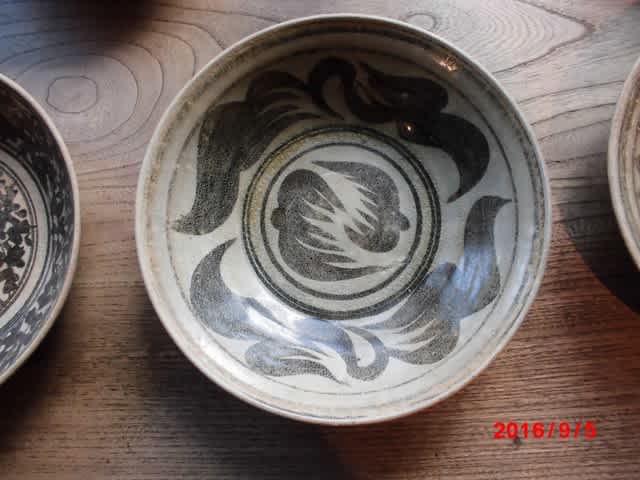
Ka-Long: Iron painting-birds pattern plate, Mr.K collection in JPN
Bird pattern has a little margin, but there are almost no margins in the flower pattern plate, and it is the characteristic of Ka-Long pottery that is full of patterns.
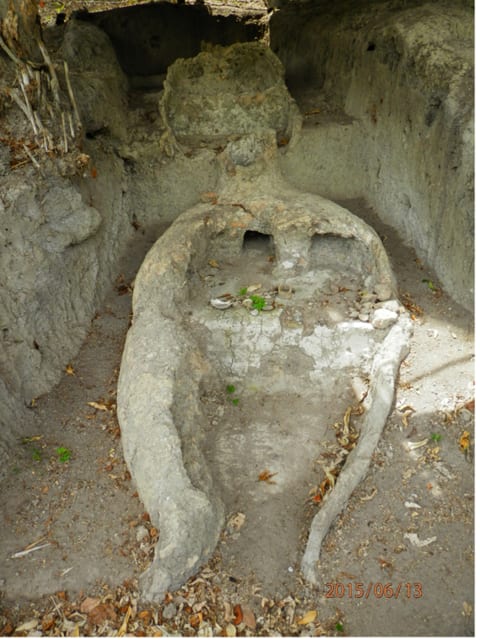
Ka-Long: Mae-Hiew Sao-Keaw kiln site
Crossing the east ridge from Thung-Mahn village in Ka-Long district, it will become Wang-Nua district Lampang Province, and it will lead to the Valley of Creek called Me-Hiew. There was a hole kiln on the slope of Mr. Sao-Keaw 's orchard, 1.3 km east of the Creek. After that I called someone in the orchard. Fortunately, someone is Mr. Sao Keaw.
He took me to the kiln site. The photo kiln is that. It was a special kiln, and two hole kilns were joined. According to Professor Sayan investigated, they were kilns built in the 15th and 16th centuries, a large kiln was built in the lower stage and the chimney was connected to the combustion chamber of the upper small kiln.
Phayao ceramics and old kiln site
Phayao's ceramics(pottery) is quite varied, but among the famous pottery there is a plate(dishware) covered with brown glaze Arabesque pattern on the inner wall of the ware. As another feature, there is a brown plate that is difficult to distinguish from Stamping twin fish pattern plate of Sankampaeng. I do not have enough page to explain how to distinguish it, so I would like to hand it over to another opportunity. The lower photo is the representative two plates.
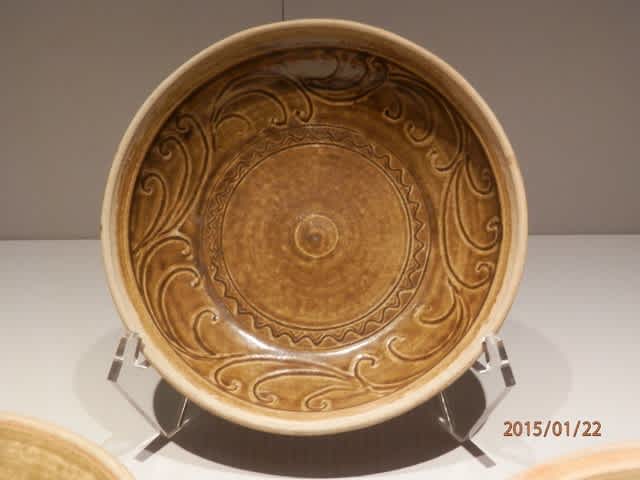
Phayao Brown glaze-Arabesque pattern plate
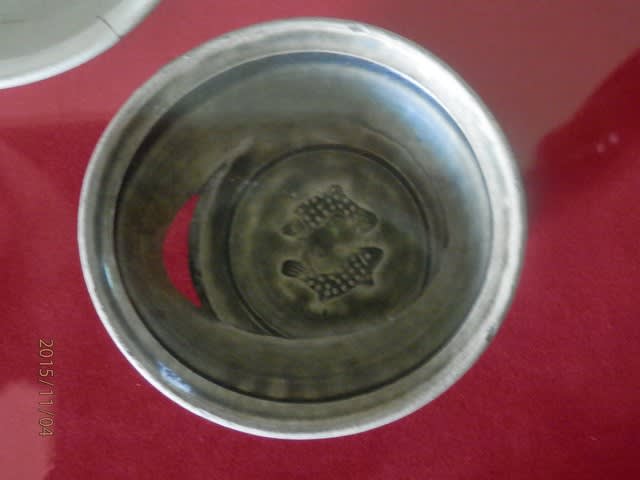
Phayao :Brown glaze-Stamping twin fish pattern plate at the Museum of Gao Ma-Fuang kiln site
First, although it is Arabesque pattern plate(dishware) of the Phayao, the cray used for Phayao and Sankampaeng pottery(ceramics) is a cray with a lot of iron, and when it is fired it has a dark brown color. To make it beautiful, the potter will slip the white clay.
Immediately after the plate(dishware) slips the white clay, potter's fingertip claw or chopsticks, scratching the surface and making the arabesque pattern and firing it with iron-containing glaze, the plate like a photo It will be completed. Such scraping pattern is the characteristic of Phayao.
Moreover, the plate which expressed fish pattern using Stamp like Sankampaeng is one of the features of Phayao. Compared with Sankampaeng, the plate of pattern is easily distinguishable from Payao, but there are very similar plates that are difficult to judge. When comparing the two plates, the position and the number of the fins of the fish are different, and it will be judged accordingly.
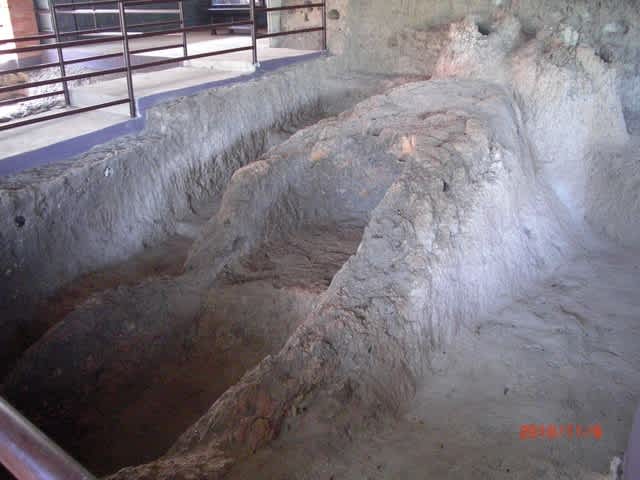
Phayao: Gao Ma-Fuang kiln site
The contribution of Bangkok Insurance Company, a museum has been built and the old-kiln site is preserved among them. The kiln is a hole kiln, its shape is common to the Northern Thailand.
Phan ceramics and old kiln site
The Phan kiln is located in the northern territory of Thailand.
That is the ceramics mainly composed of celadon fired in the kiln of Phan district, Chiangrai province. Celadon color is suitable for Jade color and vividly colored, It is not inferior to Si-Satchanalai Celadon.
And it is carved with a special instrument, which is characteristic and features a star pattern or a three-petals flower pattern as seen in Myanmar ceramics.
In addition, I will introduce the plate which fish patterned like the migration of the character of Phan ceramics.
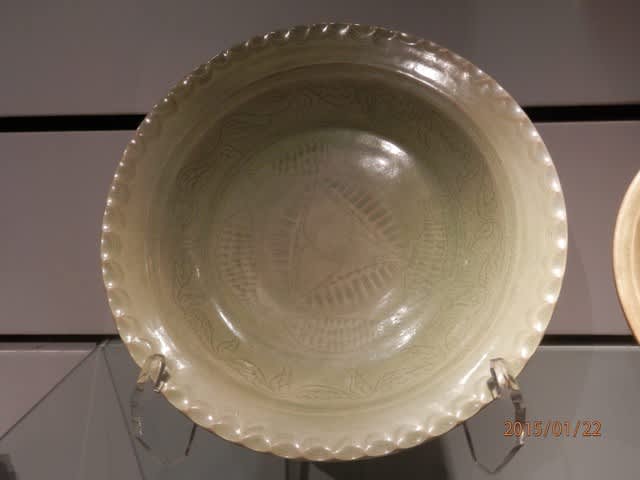
Phan: Celadon incised four fish pattern plate BKK university-Southeast Asian Ceramics Museum
The plate of the photo is a large diameter plate with three petals flower mentioned and four fish are swimming to the right on the inner wall. Which is truly spectacular.
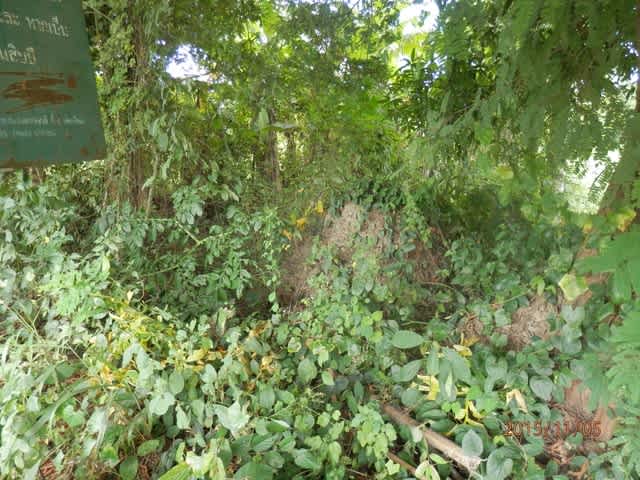
Phan: Sai-Khao old kiln site
The Sai-Khao kiln remained in the 【龍眼:Longan】field and almost in a collapsed state. The center of the picture is site of chimney.
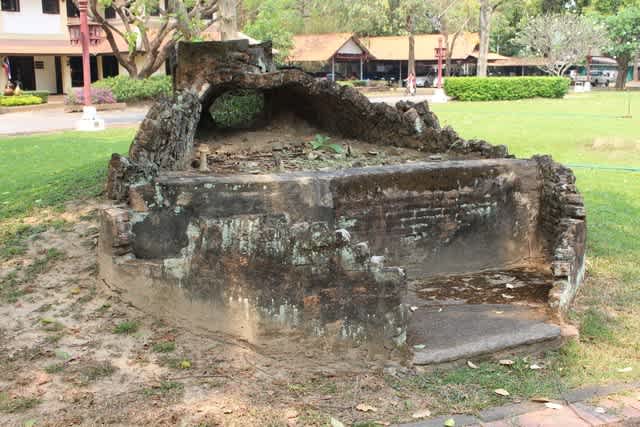
Phan: Pong-Daeng old kiln
The Poeng-Daeng kiln is one of the Phan kilns group. The Poeng-Daeng kiln has been moved to Chiangmai national museum s front yard and the exhibited. And the Poeng-Daeng kiln keeps its original shape.
It is the largest kiln in Northern Thailand, with a total length of about 10m ground type hole kiln(Ground type cross draft kiln), the age is said to be the14-16th century.
This kiln is the most advanced kiln in the northern Thailand, when you observe it, you can see that the kiln wall is doubled. It is necessary to do it in reducing atmosphere in order to fire the celadon, it is considered to be done to prevent the ceiling and the kiln wall form collapsing as the internal pressure of the kiln rises, and to improve the airtightness.
<Continue to next time>




















※コメント投稿者のブログIDはブログ作成者のみに通知されます